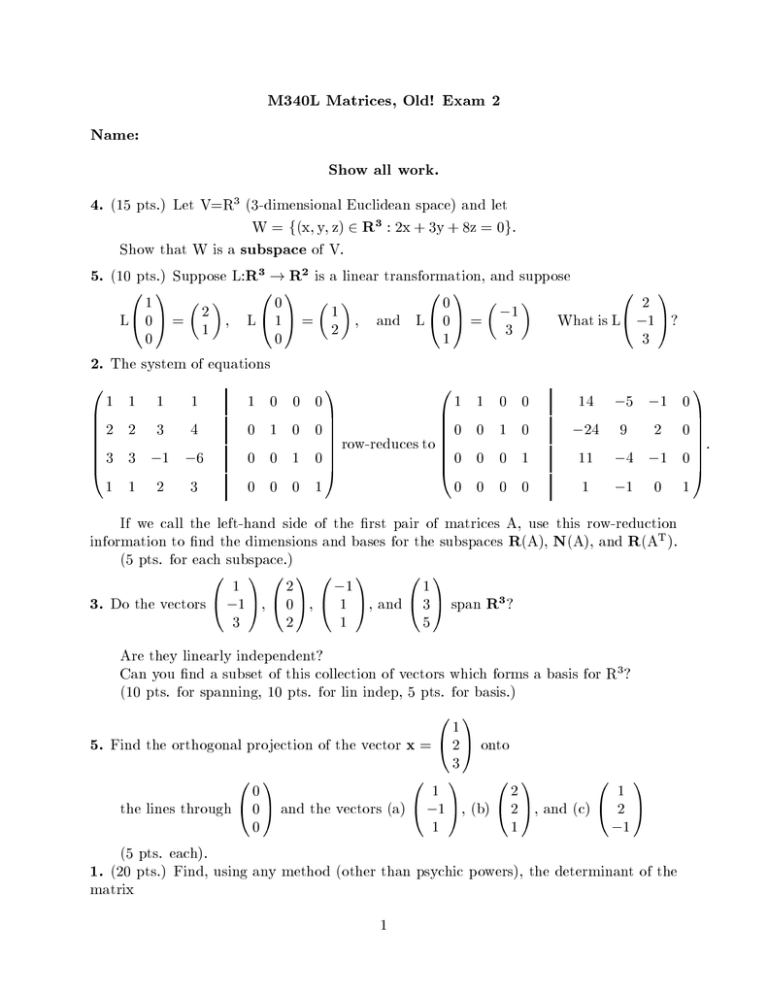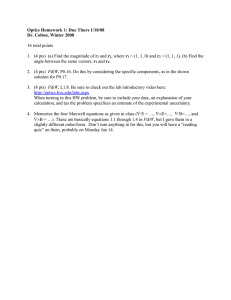¼ ½ ¼ ½ ¼ ½ ¼ ½ ¼ ½ ¼ ½ ¼ ½ ¼ ½ ¼
advertisement

M340L Matrices, Old! Exam 2 Name: Show all work. 4. 5. (15 pts.) Let V=R3 (3-dimensional Euclidean space) and let W = f(x; y; z) 2 R3 : 2x + 3y + 8z = 0g. Show that W is a subspace of V. (10 pts.) Suppose L:R3 ! R2 is a linear transformation, and suppose 0 1 1 2 L@ 0 A = 1 0 2. 0 1 0 1 L@1A = ; 0 The system of equations 0 1 B B 2 B B B B @3 1 1 1 2 3 4 3 1 1 1 2 6 3 2 > > > > > > > > > > > > > > > > > > > > > ; and 0 1 0 L@0A = 1 1 0 1 C B B 0C 0 C B C B row-reduces to C B 0C B A @0 1 3 1 0 0 0 1 0 0 0 1 0 0 1 0 0 0 1 0 0 1 0 0 0 0 0 0 0 1 0 What is L@ > > > > > > > > > > > > > > > > > > > > > 14 24 1 2 1 A? 3 5 9 2 11 4 1 1 1 0 If we call the left-hand side of the rst pair of matrices A, use this row-reduction information to nd the dimensions and bases for the subspaces R(A), N(A), and R(AT ). (5 pts. for each subspace.) 3. 0 Do the vectors @ 1 0 1 0 1 1 2 1 A @ A @ 1 , 0 , 1 A, and 3 2 1 0 1 1 @ 3 A span R3 ? 5 Are they linearly independent? Can you nd a subset of this collection of vectors which forms a basis for R3 ? (10 pts. for spanning, 10 pts. for lin indep, 5 pts. for basis.) 5. 0 1 1 @ Find the orthogonal projection of the vector x = 2 A onto 0 1 0 0 the lines through @ 0 A and the vectors (a) @ 0 3 1 0 1 0 1 2 1 A, (b) @ 2 A, and (c) @ 1 1 1 1 2 A 1 (5 pts. each). (20 pts.) Find, using any method (other than psychic powers), the determinant of the matrix 1. 1 1 C 0C C C C. 0C A 1 0 1 0 1 @0 1 2 1 1 3A 4 2 4 . Is this matrix invertible? 2. (15 pts.) Explain why the set of vectors W is 3. not a subspace of = f(x; y; z ) j x + y + 2z = 1g 3. R (25 pts.) Show that the system of equations Ax = b, where A 0 =@ 1 1 0 1 1 2 A and b = 1 0 @ 1 2 2 A 1 is not consistent. Find the least squares solution to this sytem, i.e., the value of closest to b. 4.(20 pts.) For the matrix A 0 1 @ = 2 Ax 1 2 1 0 1 3 2A 1 1 1 1 nd bases for, and the dimensions of, the row, column, and null spaces of A. 5. (20 pts.) Find all of the solutions to the equation Ax = b, where A . 0 1 @ = 2 1 2 2 1 4 3 3 A and b = 1 2 1 2 0 @ 1 2 2A 0 A friend of yours runs up to you and says `Look I've found these three vectors v1 ; v2 ; v3 in R2 that are linearly independent!' Explain how you know, without even looking at the vectors, that your friend is wrong (again). 5. 2


